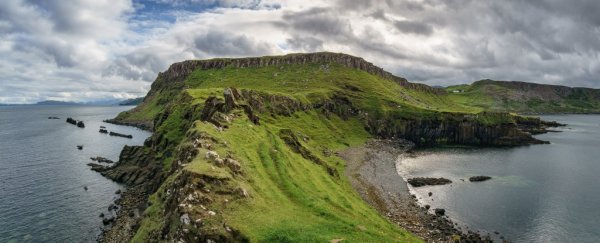A hidden treasure trove of dinosaur footprints has been discovered in Scotland, and it may help shed light on an important, but fossil-poor period of dinosaur evolution. The prints date back 170 million years ago, to the Middle Jurassic - a timeframe that has yielded little to the fossil record.
The rare site was found at Rubha nam Brathairean (or Brothers' Point) on the Isle of Skye, and it contains around 50 beautifully preserved dinosaur prints.
Most of them belonged to sauropods - long-necked herbivores such as Brachiosaurus. But there's also a smattering of theropods - carnivores that walked on their hind legs, such as Tyrannosaurus, gathering around what was once a shallow lagoon.
From around 174 to 164 million years ago - the Middle Jurassic - dinosaur fossils in rocks are scarce, because not many of the sedimentary sequences from that time are well exposed on the surface of Earth.
The Isle of Skye is one of the few places where they can be found, and this discovery marks the second time an extensive footprint site has been found there. The first, announced in 2015 and located at Duntulm, contains hundreds of prints.
These records are crucial, because it was an important time in the evolutionary history of dinosaurs - a fact that makes the lack of Middle Jurassic fossils frustrating for palaeontologists.
"This epoch was an important time in [dinosaur] evolution, when the first birds probably took to the skies, the earliest meat-eating tyrannosaurs and plate-backed stegosaurs diversified, and long-necked sauropods begin growing to colossal sizes," the researchers wrote in their paper.
The site itself was difficult to study. It's in an isolated location, buffeted by the sea and inclement weather; erosion processes and landscape changes have made some of the prints difficult to find and identify.
However, in spite of this, a team of researchers from the University of Edinburgh managed to positively identify two trackways and many isolated footprints.
Based on the shapes of these prints, captured using drones and cameras, the researchers figured out they were made both by more rounded sauropod feet and three-toed, bird-like theropod feet.
 One of the most striking sauropod footprints at the site. (dePolo et al/Scottish Journal of Geology)
One of the most striking sauropod footprints at the site. (dePolo et al/Scottish Journal of Geology)
The exact species are yet to be identified, but the researchers tentatively believe that at least some of the sauropod tracks belong to the ichnotaxon Breviparopus.
It's not actually a fully described taxon, but a name assigned to a certain type of footprint, which is the only record of the animal we have found.
Some of the theropod prints have also been tentatively assigned an ichnotaxon - Eubrontes.
Whatever the dinosaurs were, the finding reinforces what palaeontologists discovered at Duntulm - that sauropods likely frequented and spent time in lagoons in Scotland in the Middle Jurassic.
"This tracksite is the second discovery of sauropod footprints on Skye," explained lead author Paige dePolo, who conducted the research while undergoing her Master's degree in palaeontology and geobiology.
"It was found in rocks that were slightly older than those previously found at Duntulm on the island and demonstrates the presence of sauropods in this part of the world through a longer timescale than previously known.
"This site is a useful building block for us to continue fleshing out a picture of what dinosaurs were like on Skye in the Middle Jurassic."
The researchers have also found two more footprint sites at Brothers' Point, to be further detailed in upcoming papers.
The study has been published in the Scottish Journal of Geology.
